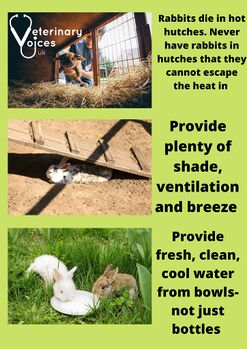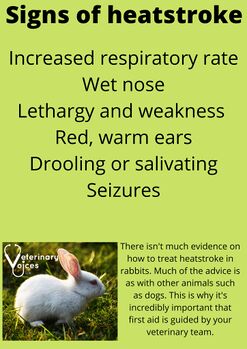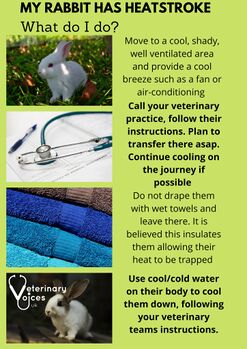Heat stroke
Heat stroke, heatstroke, heat stress, overheating, or heat exhaustion can occur when environment temperatures get too high. It is a form of hyperthermia that occurs with the natural heat-dissipating mechanisms of the body cannot accommodate excessive heat and can lead to organ failure.
"Rabbits are unable to sweat, don't pant, and heat loss is mainly via radiation from the skin of the ears which contain numerous large arteriovenous shunts. Rabbits affected with heat stroke typically have a body temperature of 40.5°C/104.9°F or above." - vetlexicon
Symptoms
- Body temperature of 105°F and above without signs of inflammation (hyperthermia).
- Weakness, depression, ataxia.
- Seizures.
- Coma.
- Muscle tremors.
- Cardiac arrhythmias.
- Abnormally high heart rate (tachycardia).
- Respiratory distress or arrest.
- Cardiopulmonary arrest.
Causes
- Hot days with ambient temperatures over 85°F.
- Outdoor rabbits in the sun.
- Lack of shade.
- Lack of ventilation.
- Lack of drinking water.
- Excessive exercise.
- Heat intolerance due to poor acclimatization.
- Thick hair coat.
- Cardiovascular disease.
- Neuromuscular disease.
- Obesity.
- Previous history of heat-related disease.
Treatment
If you suspect your rabbit has suffered from heat stroke, take them immediately to the emergency vet for hospitalization. Most rabbits will need intensive care for several days if they are diagnosed with heat stroke.[1]
Nursing care for rabbits include the following:
- Cool down the rabbit by placing cool wet cloths on the rabbit before transporting to a veterinary facility if possible. Never pour water on or soak the rabbit as this can shock them and make the problem worse.
- Convection cool with fans
- Evaporative cool
- Supplement oxygen via oxygen cage, mask, and nasal catheter.
- Give ventilatory support if required.
- Give fluid support.
Stop cooling procedures when the rabbit's body temperature reaches 103°F to avoid hypothermia.
Veterinary Voices UK
The Veterinary Voices UK Public Page (FB) has a good FB post on heatstroke. Visit their post for more detailed information. The text & images below are directly from Veterinary Voices:
✅ Provide shade, breeze and ventilation
✅ Provide plentiful clean, fresh, cold water ➡️ Remember to give bowls not just bottles too
✅ Offer cold ceramic tiles, frozen water bottles etc for them to rest on
✅ Bring inside if this is cooler than outdoors
✅ Bring inside if this is cooler than outdoors ❌ Never leave in a cage or hutch that they cannot get out of ❌ Never leave them in the sun without any shade
➡️ They need access to a cool and secure run area with lots of shade.
➡️ Signs of heatstroke vary depending on species but remember:❗High respiratory rate ❗Wet nose ❗Lethargic ❗Weak ❗Drooling or salivating
➡️ At worst heatstroke can lead to seizures and death if prompt veterinary treatment isn't accessed ⬅️
➡️ Here is the tricky bit. Small furries are very easily stressed as prey species.
☀️ Prevention is always better than cure ☀️ We do not have much evidence as to how best to provide heatstroke first aid to small furries with heatstroke while promptly transferring to your veterinary team. When asked veterinary professionals on Veterinary Voices UK suggested they would follow similar guidelines to other animals so...
✅ Move to a cold, shady, well ventilated room
✅ Call your veterinary team
✅ Use cool or cold water on your pet as per your veterinary team's directions
✅ Keep the car cool on transfer using windows or air-conditioning
❌ Don't transfer with a wet towel over them
➡️ This is first aid while you promptly transfer to your vets - all heatstroke cases require veterinary intervention ⬅️
Experiences
- Love Paws Animal Rescue. (2022). Bella's story - dumped bunny was unable to find shade in 34C weather.
Further reading
- The People's Dispensary for Sick Animals. Heatstroke in Rabbits
- Medivet. Heatstroke in rabbits
- peteducation.com. Heatstroke, Hyperthermia and Overheating in Small Pets: Signs, First Aid, and Prevention
- Special Bunny Rescue. Overheating / Heat Exhaustion
- Bunnyhugga. Heat exhaustion (heat stroke)
- My House Rabbit, Recognizing Heat Stroke in Pet Rabbits
- Debbie Ann. (2011). Learn the symptoms of overheating and keep rabbits cool on hot summer days
See also
References
- ↑ Barbara L. Oglesbee, Blackwell's Five-Minute Veterinary Consult: Small Mammals, 2e.





